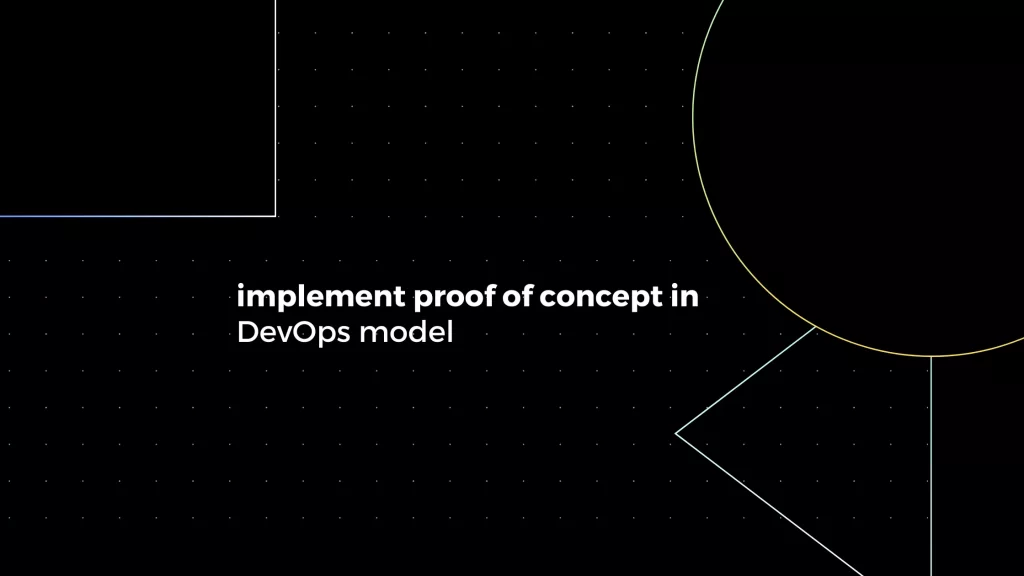How to implement proof of concept in DevOps model?

What is Proof of Concept in DevOps
A Proof of Concept (POC) presents a prerequisite model that stresses the functionality and idea of a product including its features and designs before a DevOps team produces its final version and releases it to the customers.
It is an approach that is used to explore the feasibility and the real-life application of the proposed model. It also allows a team to have a clear-cut idea of the larger picture when they get to launch the product.
A software service provider or a DevOps team can offer a POC model to their customers that help them to identify whether all the specific features work by their expectations.
A POC can enable an enterprise to better attract investors, as the POC serves as a testimony to the foolproof nature of the proposed product. Most of the SaaS providers offer a POC that enables customers to test for the availability of features. This can enable service providers to entice customers to their brand.
Prototype
Prototype refers to the visible and functional manifestation of an idea. Prototypes are used when there is uncertainty about the solution and its works. It is a working model of the product that offers some of its functionalities. Prototypes are built to facilitate firsthand testing of the product by all the stakeholders and the clients to identify any flaws within the product before its marketing.
Difference Between Proof of Concept and Prototype
A Proof of Concept is used to validate the feasibility of a project. It is used as a prerequisite to help you get started with a project. The prototype can be identified as an early version of the product that is halfway into the market. POC is the prerequisite that is needed to build the prototype. In other words, a POC serves as a testimony as far as the development of a product is concerned and a prototype throws light on how it can be implemented.
Why Proof of Concept?
POC describes the idea and proposed functionality of the product including its general design and viability and thus serves as a prerequisite before a DevOps team produces a final version and releases it for wide-scale implementation.
You should prove that a proposed model or idea is productive, practical, and feasible to get the client to accept your proposal. Offering a POC can serve as a gambit as far as the success of a project is concerned.
It is also the first step that should serve as a foundation stone for a project. It should be designed in such a way that it can solve the identified problems of customers by highlighting the specific functionalities and features.
How to Create a POC?
1) Target
Unless and until the need for a specific product is identified and specified clearly, it does not make sense to create a POC. Outline the necessity of the product by clearly identifying the target market and how it can address the customer pains or problems. So, how to know the pains of your customer? The easiest solution is to ask your customers! You can ask them to get a better idea of their needs, pain points, and future expectations. This enables an enterprise to have a crystal-clear idea of the perspectives of the customer.
2) Solutions
Once you have a clear idea of the customer pains you can brainstorm with all the concerned stakeholders regarding the best fit solution that addresses all the main constraints including the budget, technology stack, timeframe, and scope. Once you have developed an optimized solution, make detailed documentation.
3) Testing
Once a solution or idea is identified, consider developing a prototype that serves as the foundation stone for all the identified requirements, and features. The best people to test the product are your customers. You can designate the task of testing the product to the most tech-savvy group of customers or the power users.
4) Feedback
Customer feedback is a treasure trove of information. Once the prototype is tested, gather the feedback and suggestions of your customers. Acting on this can help you to taste better success once the product is launched.
Advantages of Having a Proof of Concept Model
Let us now see what are the possible advantages if a DevOps team could develop and offer a Proof of Concept model to their clients.
1) Plan Better
A POC can enable an enterprise to better plan the allocation of resources and thus ensure that they won’t run out of resources when it comes to the actual implementation of the project. It can help you to procure the resources at the right moment and thus ensure the successful completion of the project within the scheduled time frame.
2) Identify the Risks
Creating a POC can help an enterprise to identify the possible risks and roadblocks that can pop up during the implementation of the project. Rather than getting caught unawares, a POC can help an enterprise to make better preparations for the foreseeable risks. This can be about the deliverables that are related to a project. The identified risks can be documented in a risk register along with an appropriate strategy that helps the team tackle them. This helps a team to better deal with risk if it were to occur.
By ensuring that the product is not susceptible to any risks and failures, POC can help you to eliminate the cost overheads. Consider a situation in which you delivered some faulty products and were required to recall them back. Not only are you incurring additional cost overheads but your customer reputation is also at stake. It is here that the relevance of a POC model becomes all the more important. A POC model can help you to avoid such untoward situations. Once you have a POC model with you, you can gain the confidence of the investors. It can help you to attract investors and thus better budget your requirements, which also enables you to ensure that you won’t run out of budget halfway.
3) POCs are customizable
Since a POC strategy emphasizes feedback, it can help you to incorporate the suggestions and thus reframe your objectives and goals and again budget your requirements. Such a model can enable you to eliminate the cost overheads as it helps you to verify the different use cases and assumptions before making any investments
4) Ensure that Projects are on Track
Identifying a suitable idea that acts as the best fit solution for all the identified constraints and implementing a POC model from the very start of the development process can help you to ensure that you do not spend time and energy on ideas that are less likely to fructify. This can enable an enterprise to ensure the timely completion of its projects.
5) Better Hands-On Experience
There is a lot of difference between formulating an idea and putting it into practice. When it comes to implementing an idea, you will face hiccups as the process is not a cakewalk. A POC helps you to identify this exact limitation which you are sure to experience when it comes to the actual implementation.
Conclusion
A POC model enables developers to explore the scope and viability of a product. It also enables them to wade through the roadblocks when it comes to the actual implementation of the product.
Activelobby offers DevOps consulting services for organizations that are looking to kickstart their journey to DevOps. As part of our DevOps services, we also assist clients in the implementation of their development strategies.
We have expertise with tools like Ansible, Docker, Chef, Puppet, and Kubernetes. We can offer you the best possible combination of these tools that can help you with the implementation of your development strategies.
